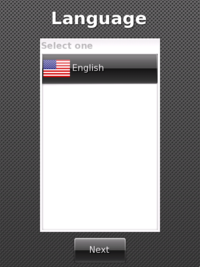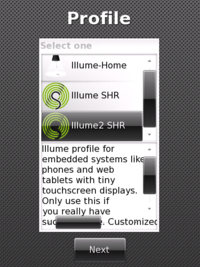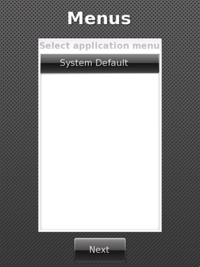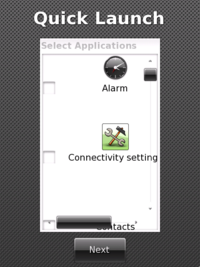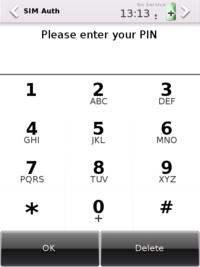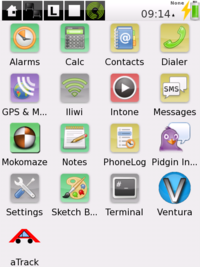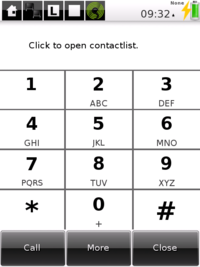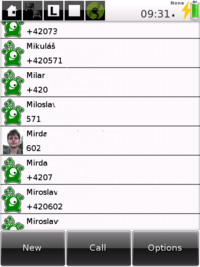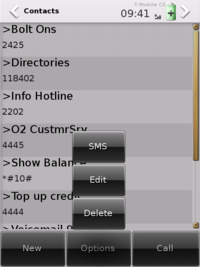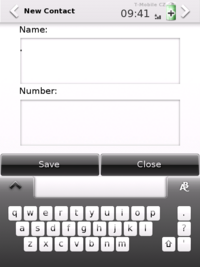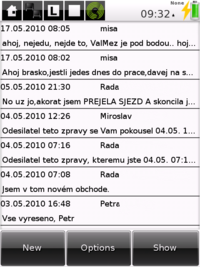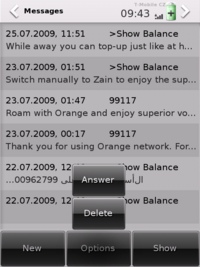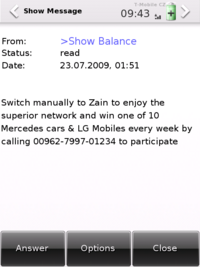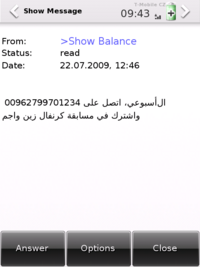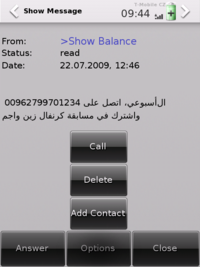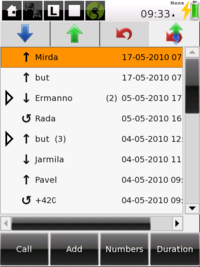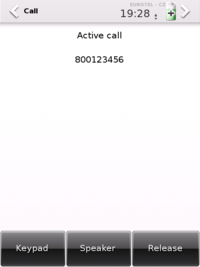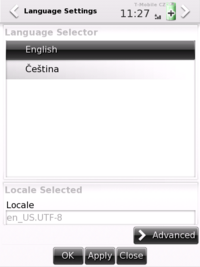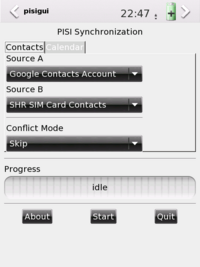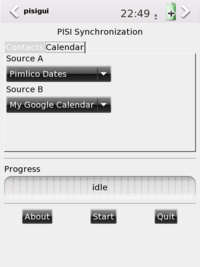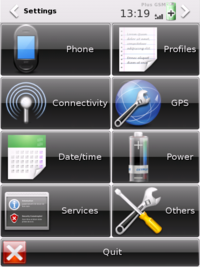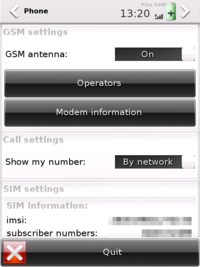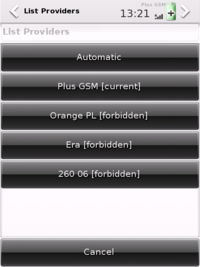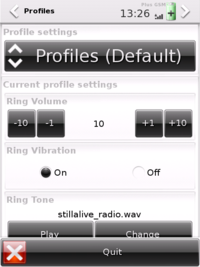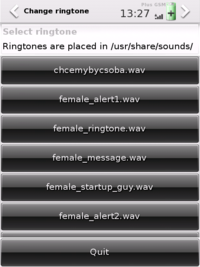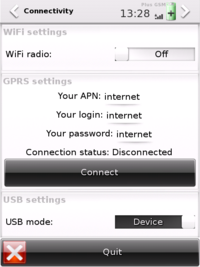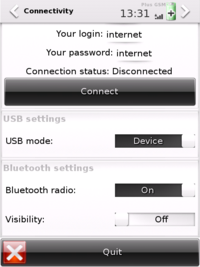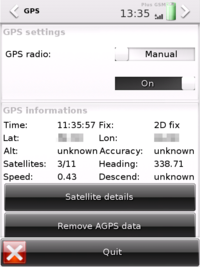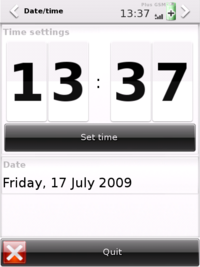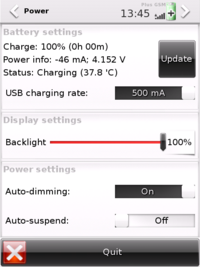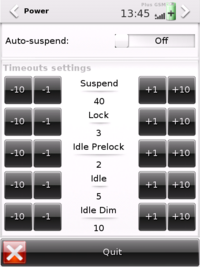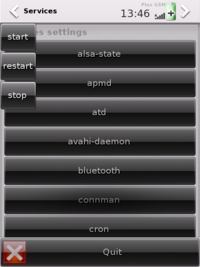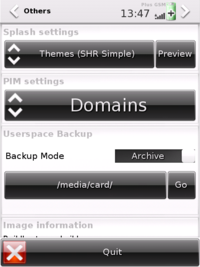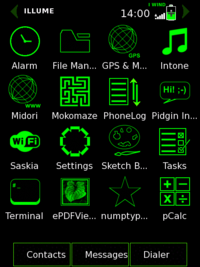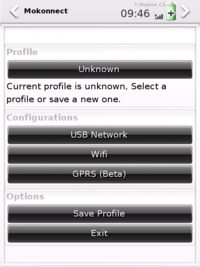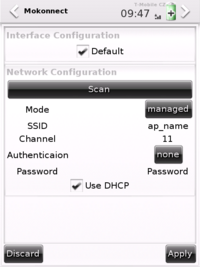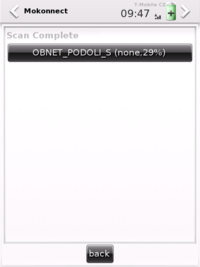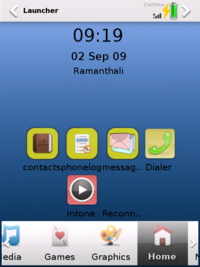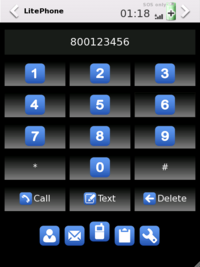Work in progress. Comments here
SHR Introduction
Welcome to SHR, the world of community driven distribution for (not only) OpenmokoNeo phones.
SHR (Stable Hybrid Release) is here to provide you with Root FileSystem images that you can easily install onto your Freerunner to use is as a daily phone. It's filled with prepackaged software that can be installed upon demand by users, it can also be used by developers as a base image for customized and flavored distribution or release. SHR unstable is a testing environment before software get stabilized and it is the main testing ground for FSO releases. SHR testing images (currently not available) provide as much stability as possible to be used during day-to-day operations.
SHRhas been evolving from a simple release of customized software into a full distribution. Therefore, in SHR you can choose from several different graphical toolkits (for example GTK or EFL), different phone managers (SHR or Zhone), web browsers and other programs.
The SHR Team is busy with software and system maintenance and building so you can concentrate on programming, using and reporting bugs.
SHR Specific
At this point, there are some applications and procedures that are purely specific to SHR and would not run on another distribution. For example the phone applications (Dialer, Messages and Contacts) and SHR Settings depend heavily on the ophonekitd daemon.
As SHR is based on FSO, basically any application using FSO has a chance to run, should all required libraries be available.
Installation
Getting SHR
First, determine which model of phone you have, the GTA01(neo1973) or the GTA02(FreeRunner).
You need to download two files for your version as above, kernel and root filesystem. Depending whether you will be installing into the internal nand memory or on µSD card, you need to either get .jffs2 file for nand or .tar.gz file for µSD.
At this point, there are no recent testing images so for the GTA02 Freerunner you need to download the images of unstable release from http://build.shr-project.org/shr-unstable/images/om-gta02/
- Get the latest kernel - search by date or it's usually named uImage-om-gta02-latest.bin
- Get the root filesystem shr-image-om-gta02.jffs2 (for nand) or shr-image-om-gta02.tar.gz (for µSD)
You can also choose an image with less packages, marked as lite. You can then upgrade to the full image by running
opkg update
opkg task-shr-apps task-shr-games task-shr-gtk
TODO: confirm
| |
Full image content |
SHR-Image LITE Content
|
| Window Manager |
|
|
| Engine |
|
|
| Telephony |
- Dialer (Call/Receive, DTMF, Speaker mode)
- SIM Contacts (Call/Modify/Create/...)
- SIM Messages (Receive/Compose/Answer/...)
- Pyphonelog (received/emitted/missed calls logging)
|
- Dialer (Call/Receive, DTMF, Speaker mode)
- SIM Contacts (Call/Modify/Create/...)
- SIM Messages (Receive/Compose/Answer/...)
- Pyphonelog (received/emitted/missed calls logging)
|
| GPS |
|
|
| Utilities |
- Calculator
- Alarm
- GPE Scap (Take screenshot)
- GPE File Manager
- GPE Sketchbook
- vala-terminal
|
- Calculator
- Alarm
- GPE File Manager
- vala-terminal
|
| Media |
|
|
| Internet |
|
|
| Games |
|
|
| Settings |
- SHR Settings
- Mokonnect (Network Manager)
|
|
View the sources: http://git.shr-project.org/git/
Installation on Flash
In order to install your SHR distribution directly to your Freerunner Flash memory (NAND), you need to get the desired filesystem file ( .jffs2 ), from http://build.shr-project.org/, and flash your device using the dfu-util tool.
Please visit Flashing_the_Neo_FreeRunner to know more about how it works or Dfu-util for more detailed information about the tool.
Specific dfu-util command to flash the filesystem:
dfu-util -a rootfs -R -D rootfs_filename.jffs2
Remember to flash kernel too if required
Installation on µSD Card
Installing SHR on your µSD Card depends on the Bootloader you are using, uBoot or Qi.
In simply words, diference between both systems resides on how you must prepare your µSD Card and files you use to fill them:
If you use uBoot, you need to create two partitions. First partition, not so big, in FAT16 where you have to place the kernel file (.bin) and second partition in ext2 or ext3 where you have to uncompress the filesystem file (.tar.gz).
If you use Qi, you only need a ext2 partition into your µSD Card where you uncompress the filesystem image file (.tar.gz). In this case boot is going to look for the kernel image into the /boot directory, normally comes into tar.gz file, named as uImage-GTA02.bin .
Please visit links bellow for detailed information and tips:
For uBoot ( boot from microSD card ) and for Qi.
SHR version
Shell you ever later wonder what version of SHR you have actually installed, please run
cat /etc/shr-version
or check SHR Settings -> Other -> Image information
Running SHR
Booting
Press the power button shortly once to start the Freerunner. Booting splash screen will appear. First boot after new installation takes always a bit longer. Sometimes, it is recommended to reboot after this first boot, to make sure all packages got initialized properly.
Initial Setup
On the first boot, Setup is automatically initiated to walk the user through basic setup of the Enlightenment desktop environment. You are able to choose preferred language of the desktop environment, Illume SHR themed profile or select default menu (only one at the moment). On the Add icon screen you can add icons for some application. If you add a terminal based application like mplayer, you will see an icon but no application running upon click, as it will run in the background. Last screen allow settin up quick launch applications. TODO: what does quick launch do anyways?
SIM Auth
SIM Pin is asked for upon start up.
First look
Illume desktop is default home screen of the SHR desktop. Application files located in /usr/share/applications are displayed here. All applications are ran fullscreen and you can switch between them by using the Task switcher in the Top Shelve or by using the < left or right > arrows in the Top Shelve.
The Illume desktop can be easily customized - slide the Top Shelve down and tap the Settings icon (Wrench).
|
|
NOTE: TIP: for better access of the Settings icon, tap and hold the Settings icon, then drag it to the right.
|
Illume settings provides various options to alter the desktop environment. You can change sizes of elements, single or double click, wallpaper. To access all the various options, open Illume Settings and slide the visible icons to the left, to preview more options on the right hand side.
The little applets in the Top Shelve (for example Battery, GSM, Bluetooth etc.) are called Shelve gadgets and you can configure whether they are visible (on the front part of the top shelve) or hidden (you can access them by sliding the top shelve) through Illume Settings -> Display -> Shelve gadget.
Some screens are not resized properly to fit the Freerunner's display - for example the Wallpapper setting. This is a known bug already reported upstream.
Phone applications
Besides other software, SHR comes with 4 main phone applications: Dialer, Contacts, Messages and Phone log.
Upon a missed call or an unread message there is a notifying daemon that shows a screen with button to run Messages or Phonelog application.
First steps
Right after installation and first boot you might want to do a few initial steps:
Establish network connection and SSH into your Freerunner. The root account uses no password by default. You can establish connection either via USB to your desktop and enable NAT or you can connect through Wifi. If you use USB, some setup is required on the desktop side, please read USB_Networking. For Wifi, you can use Network Manager
Check if GSM is working correctly - observe the GSM gadget in the Top Shelve and see reported signal of your GSM operator
Check and set call volume - this is handled by alsa state files in /usr/share/shr/scenarii/ . To customize speaker volume edit /usr/share/shr/scenarii/gsmheadset.state and change control 4. Values between from 105 to 120 might be sufficient.
Shell you want to alter more parameters be aware that each file is a set of value for the 94 parameters. Some of the important ones are:
Control 48: internal mic of the tel (set to 2 or 3)
Control 4 : internal speaker (set from 110 to 120)
Control 49: headset mic
Control 3 : headset speaker
Initialize opkg database in order to install some applications from SHR repositories or from other sources, for example [opkg.org]. While still being online, you need to first run
opkg update
Searching in the opkg database can take a long time. You can speed things up by dumping the database into a file and grepping it through.
Do this only once or after every opkg update:
opkg list > packages.txt
Then you can search quickly for package name, for example for navit:
grep navit packages.txt
SwapSpace
The Freerunner has only 128mb ram, when this is used up applications get killed. This is particularly bad while doing opkg upgrade.
WARNING: this mights kill your sd card, since there might be a lot of read/writes to the same spot.
dd if=/dev/zero of=/swapfile bs=1024 count=65536
Add a line to fstab so next time you boot there will be swap
echo "/swapfile swap swap defaults 0 0">> /etc/fstab
Make swap
mkswap /swapfile
Make the swap file work now:
swapon /swapfile
Changing root password
SHR is shipped without root password (just press enter)
This is very dangerous if you connect using wifi, or USB. You need to activate the root password:
passwd
then type your selected password (2 times)
Under the hood
SHR is based on linux kernel and Openembedded. XGlamo is providing X server environment and Illume (Enlightment window manager module for small devices) is providing comfortable finger controlled desktop environment. Under the hood of the pretty desktop there is FSO middleware talking to the GSM modem, GPS module as well as to the other bits of hardware. SHR ophonekitd daemon is run with X server start up and it communicates with FSO via d-bus. SHR phone applications talk to ophonekitd and also to FSO so for example when you receive a phone call, the dialer is launched to provide a way of answering it. Dialer, Contacts and Messages applications are part of the SHR internal libframeworkd-phonegui-efl library, Phone log is an extra application written in python-gtk.
Localization
You can change the language of the SHR desktop environment by using the Settings of Illume. For Example, for Czech language: in Illume Top Shelve go to Wrench (Settings) -> Language -> Language Settings -> and choose: Čeština. If your language is not in the menu you can install by using opkg.
You can list all available languages by running:
opkg list | grep glibc-locale-
And install the language of your choice (for example czech):
opkg install glibc-locale-cs
After this, the Language Settings of Illume will offer Czech.
This will localize the Illume environment and will also set correct lang environment variable. If you wish to have translations for other applications, you need to install them again (presuming they are available):
This will install czech localisation for SHR phone applications, SHR Settings and TangoGps:
opkg install libframeworkd-phonegui-efl-locale-cs shr-settings-locale-cs tangogps-locale-cs
For localized terminal environment (ssh login) set lang variables set /etc/profile, example for Czech language:
export LANG=cs_CZ
export LC_ALL=cs_CZ
The Illume keyboard offers english dictionary correction by default. You can list all the dictionaries available for installation:
opkg list | grep illume-dic
If your language is not available and english is bothering you, you can set an empty dictionary:
echo "" > /usr/lib/enlightenment/modules/illume/dicts/None.dic
By using it, it will get filled by the words you use and after time will start helping and correcting your typing.
Date and time
Timezone is automatically retrieved from the GSM network. Date and time are automatically set from GPS or Network. The easiest way of setting the time for the first time is to run TangoGps (GPS & Map icon) and obtaining GPS fix. Time will then be set automatically after several minutes.
Time can set time also manually.
Via SHR-Settings -> Date/time -> Set time
From linux based desktop:
ssh root@192.168.0.202 "date -u -s `date -u +%m%d%H%M%Y.%S`"
You can also set the hardware clock to the system time:
hwclock --systohc
Data synchronization
You can synchronize your contacts and appointments data with various sources. The sync can by done by program called PISI http://pisi.projects.openmoko.org/ . SIM contacts and calendar entries are currently possible to sync on SHR.
For calendar install dates
opkg install dates
Supported Contacts data sources:
- SIM via DBUS (e.g. SHR)
- QTopia address book (e.g. OM 2008.12)
- LDAP (read only)
- VCF files (local / webdav)
- Google contacts
Supported Calendar data sources:
- Google calendars
- ICalendar files (local / webdav)
To install PISI, run
Configuration example, .pisi/conf to sync contacts and calendar with google calendar and contacts with google mail:
[googleCalendar]
description=My Google Calendar
module=calendar_google
user=user@gmail.com
password=secret
calendarid=user@gmail.com
[pimlicodates]
description= Pimlico Dates
module=calendar_ics
path=/home/root/.evolution/calendar/local/system/calendar.ics
[googlecontacts]
description=Google Contacts Account
module=contacts_google
user=user@gmail.com
password=secret
[shrsim]
description=SHR SIM Card Contacts
module=contacts_dbussim
max_simentries = 250
simentry_name_maxlength=18
SHR Settings
SHR Settings is the main setting application of SHR. In the background it uses FSO specific dbus calls as well as low level commands. The graphical interface is Elementary-Python based. It provides an easy way of setting up your phone to your liking - from phone related settings, to requesting resources in order to prevent screen dim or suspend (for example while using GPS).
While some settings are persistent over reboots, other are not.
TODO: list persistent/non persistent settings, or make a note at each section
Main Screen
Main screen is divided into few categories, which contain modules. Every SHR Settings module has specified task - control GSM antenna power, set actual time etc.
Phone
GSM
In GSM settings you can turn off and on GSM module. After turning off antenna, whole GSM modem is turned off.
To list available providers, click on Operators button. Scanning can take some time. After while, list of operators should pop up.
You can't connect to operators marked [forbidden]. After failed connect, message is displayed.
Selecting operator from list also changes modem registration mode to manual. It won't register to other network, even if some is available and has better signal strengh. To return to automatic mode, click "Automatic" button in operator list.
Call
You can set if your phone number should be displayed to other party. You can either depend on network decision ("By network") or force it manually ("Manual")
SIM
Here you can view some informations about your SIM card and clean phone and messagebooks.
Others
Profile
Here you can select current profile, which device should use to determine ring tone etc.
Current profile
Here you can adjust properties of currently used profile. Available settings: ring tone, ring volume, ring vibration, ring loop, ring length, message tone, message volume, message vibration, message loop, message length.
To change ring tone, click on "Change" button.
To use your own ring tone, place it in /usr/share/sounds directory.
After selecting sid tune as ring tone, there are available controls to select tune number from file.
This is changing settings in /etc/freesmartphone/opreferences/conf/phone/default.yaml
ring-volume # Ring Volume control 0 (mini) to ? maxi)
ring-length # min time for ringtone. Must be greater than the duration of you ringtone
ring-loop # define the number of loop of ringtone to play
ring-tone: "ringtone_ringnroll.ogg" # .ogg example
ring-tone: "Arkanoid_PSID.sid" # .sid example, use default tune
ring-tone: "Arkanoid_PSID.sid;tune=2" # .sid example, plays the second tune of that
If you like to test a .sid you can play it using this command on the FR:
gst-launch filesrc location=Arkanoid_PSID.sid ! siddec tune=2 ! alsasink
Note: it's used a ! not a | to construct the gstreamer pipe command.
Connectivity
WiFi
With "WiFi radio" toggle you can set, if wifi module should be powered. WiFi radio has to be turned on before trying to connect to WiFi network.
TODO: obsolete, Kmokonnect turns wifi on automatically
GPRS
To enter APN, login and password fields, just click on actual value (default: "internet"). Keyboard will pop up.
NOTE: If you don't know APN, login and passwork, ask your provider.
TODO: obsolete, Kmokonnect provides gprs support now
To connect to GPRS network, just click "Connect" button. Entered values will be saved after successful connection.
USB
With this toggle you can switch USB port between device (Neo to PC) or host (device to Neo) modes.
Bluetooth
To power up Bluetooth module, swith "Bluetooth radio" toggle to "On". After that, "Visibility" toggle should arrive - set it to "On" if you want your FR to be visible by other Bluetooth devices on scanning.
GPS
GPS
By default, GPS is turned on only when requested (when you turn on TangoGPS, Navit, omgps or other GPS app). That state corresponds to "Auto" setting. After changing to "Manual", you can set it on all the time.
GPS information
This page can be used to monitor GPS status. If some value isn't known, then "unknown" is displayed.
You can also view information about every visible satellite and check, which are used for getting fix. To do that, just click "Satellite details".
If you experience problems with GPS, turn it off, click "Remove AGPS data" and reboot your Neo.
Date/time
Time
Here you can view and set actual time. By default, time is just displayed, To adjust it, click on "Set time".
After finishing adjusting, click "OK" button.
Date
This module displays current date.
Power
Battery
This module displays informations about battery state - charge, voltage, remaining time etc. To update data, click "Update" button.
Here you also force enable 500mA charging.
Display
With this slider you can easily tweak backlight power.
NOTE: This setting isn't permanent over sessions. At boot backlight is set back to 100%.
Power
Here you can turn on or off automatic dimming or suspend after idle timeout (see: Timeouts module)
Timeouts
Here you can set up values of idle timeouts used by device. Timeouts are reached in this order: idle -> idle dim -> idle prelock -> lock -> suspend. Idle, idle prelock and lock aren't used by default in SHR at the moment. This setting changes parameters in /etc/frameworkd.conf :
[odeviced.idlenotifier]
suspend = 20
lock = 2
idle_prelock = 12
idle = 10
idle_dim = 20
Services
Services
Here is listed every interesting script from /etc/init.d/ directory.
After clicking on some, you can either start, restart or stop service and view result.
Others
Splash
With this selector you can select theme used by shr-splash at boot and shutdown. After clicking "Preview", selected boot image will be displayed for 5 seconds.
PIM
Module used by opimd developers. Doesn't have influence on behaviour of default SHR image.
Every opimd domain has different backends to store it's data. The domain reads data from every backend and writes data to the default backend. So with the selector in shr-settings you can choose the backend that stores newly generated data, it doesn't copy or move existing data to a different backend.
Userspace backups
Here you can either archive or restore your files and configurations. (TODO)
Image information
This module contains basic information about installed image - name of buildhost, used revision, branch and time of build.
Theming
Find available themes by running
opkg list | grep theme-illume
install it by
opkg install e-wm-theme-illume-sixteen elementary-theme-sixteen
http://opkg.org has a very fast theme called nEo
opkg install http://www.opkg.org/packages/e-wm-theme-neo_0.2_armv4t.ipk
opkg install http://www.opkg.org/packages/elementary-theme-neo_0.2_armv4t.ipk
opkg install http://www.opkg.org/packages/etk-theme-neo_0.2_armv4t.ipk
opkg install -force-overwrite http://www.opkg.org/packages/libframeworkd-phonegui-efl-theme-neo_0.2_armv4t.ipk
If you also want the GTK+ Applications to fit in with the rest of the Systems look execute
opkg install http://www.opkg.org/packages/gtk-theme-neo_0.1_armv4t.ipk
For a completely monolithic look additionally execute
opkg install http://www.opkg.org/packages/gpe-theme-neo_0.1_armv4t.ipk
opkg install http://www.opkg.org/packages/icon-theme-neo_0.2_armv4t.ipk
Please observe the command line output when installing these themes, since it will tell you how to activate the themes.
Note that some of the theme packages have to be reinstalled after an opkg upgrade.
Please note that reverting back can be done by
opkg install e-wm-theme-illume-sixteen shr-theme-gtk-e17lookalike -force-reinstall
opkg install libframeworkd-phonegui-efl0 e-wm-theme-default etk-theme-shr shr-theme -force-reinstall
Network manager
While there are several ways of networking - Wifi, USB, Bluetooth and Gprs - By default, USB networking is enabled in /etc/network/interfaces.
Enhanced configuration is possible through direct editing of /etc/network/interfaces or through Mokonnect.
Connmand daemon with Mokonnect are the recommended user level applications for setting up networking. At the moment, Mokonnect can manage USB, Wifi and Gprs connections. Wifi device is not required to be manually turned on via SHR-Settings as Mokonnect will automatically enable the device when needed and disable after use.
TODO: screenshots, supported encr. wifi
System Customizing
Changing the splash screen
list available splash screen themes
opkg list | grep splash-theme
and install one of the available themes
opkg install shr-splash-theme-dontpanic
Then go to SHR Settings -> Others -> Themes. Here you can preview installed themes and change the default one.
Install functional alarm application
opkg remove -force-depends elementary-alarm; opkg install ffalarms
Enable mouse cursor
edit line 121 of /etc/X11/Xinit and erase -hide-cursor
ARGS="$ARGS -dpi ${DPI} -screen ${SCREEN_SIZE} -mouse tslib -root-ppm /usr/share/pixmaps/xsplash-vga.ppm vt1"
Connect Bluetooth keyboard
Turn Bluetooth on in SHR Settings -> Connectivity, then in terminal run
hidd --search
Improve speed of Elementary applications
Set the Elementary rendering engine used for Evas to x11-16 (Software X11 16bpp engine, may have bugs and will be lower quality, but faster):
echo -e "#!/bin/sh\n\nexport ELM_ENGINE=x11-16" > /etc/profile.d/set-elm-engine.sh
Additionally in the SHR-Unstable repositories there are theme packages optimized for 16bpp color. Both packages can be installed with the following command:
opkg install e-wm-theme-illume-sixteen elementary-theme-sixteen
You can then append the /etc/profile.d/set-elm-engine.sh with:
# Set Optimized theme
export ELM_THEME=sixteen
You can also then change Illume to use the sixteen theme by clicking the wrench->Look->Theme-illume-sixteen->OK. Then switch Illume to use the 16bpp Engine by clicking the wrench->Advanced(you will need to drag and slide the top menu)->Engine->Software_16->OK. This should give you a much faster interface without the low quality look the default SHR themes have at this lower color depth.
Read http://trac.enlightenment.org/e/wiki/Elementary
If you try to change Wallpaper or Theme and Illume keeps on crashing, it might be caused by the whole Illume running in Software_16 mode. Go to Illume Settings, slide the icon bar and select Advanced. There tap on Engine and select Software. After this, you can change your Wallpaper or Theme. Selecting Software_16 later on again will speed up the desktop's response (though causing it to be a bit uglier).
Speedup of suspend and wake up
I you are using Qi and installation on µSD card, you can change the kernel parameter loglevel=1 1 in /boot/append-GTA02 . For u-boot and installation in nand just type
klogd -c 1
into the console. This saves you from 3 seconds worth of console output on every resume.
If you like the effect of this command and want it to be executed at every startup, you just have to log into your phone and type the following:
cat > /etc/init.d/resumespeedup << EOF
#!/bin/sh
/sbin/klogd -c 1
EOF
chmod +x /etc/init.d/resumespeedup
ln -s ../init.d/resumespeedup /etc/rc1.d/S06resumespeedup
ln -s ../init.d/resumespeedup /etc/rc2.d/S06resumespeedup
ln -s ../init.d/resumespeedup /etc/rc3.d/S06resumespeedup
ln -s ../init.d/resumespeedup /etc/rc4.d/S06resumespeedup
ln -s ../init.d/resumespeedup /etc/rc5.d/S06resumespeedup
SHR Launcher
Launcher is elementary based alternative home screen application and event notifier for SHR. It displays current time, has a user tweak-able launcher with categories and features missed calls and messages applets.
opkg install libsqlite3-0 http://www.opkg.org/packages/launcher_0.23_arm.ipk
Litephone
Litephone is new alternative set of phone applications written in Qt. In it's single application interface it provides basic phone functionality (contacts, calls, messages, phone log, settings). It's main advantage is that it uses opimd for storage of the user data.
opkg install http://pvtrace.com/litephone/libqtcore4_4.4.3-r3_armv4t.ipk
opkg install http://pvtrace.com/litephone/libqtxml4_4.4.3-r3_armv4t.ipk
opkg install http://pvtrace.com/litephone/libqtdbus4_4.4.3-r3_armv4t.ipk
opkg install http://pvtrace.com/litephone/libqtgui4_4.4.3-r3_armv4t.ipk
opkg install http://pvtrace.com/litephone/qt4-x11-free_4.4.3-r3_armv4t.ipk
opkg install http://pvtrace.com/litephone/litephone_0.0.1-r2_armv4t.ipk
Opimd utils
Opimd utils is a set of several testing scripts to play with the new opimd backends. It also provides opimd-messages program and mainly new opimd-notifier that is much better then the standard one.
opkg install opimd-utils
opkg upgrade issues
As opkg had some issues recently, installation might get broken due to that. You can fix it or prevent by using the following scripts
Safe update packages:
#!/bin/sh
opkg list_upgradable | awk '!/(kernel|Multiple)/ {print $1}' | \
while read line; do
echo "installing pack $line"
opkg install $line -force-reinstall
done
Force reinstall all installed packages
#!/bin/sh
opkg list_installed | awk '!/(kernel|Multiple)/ {print $1}' | \
while read line; do
echo "installing pack $line"
opkg install $line -force-reinstall
done
No icons, no GSM functions etc. - this is mostly due to errors on your uSD card. Remove your card and fix it in card reader or by booting to another partition (nand) or by reboot and mount read only, then run fsck.
For reboot into nand and fix 1st partition of ext2 on your card
fsck.ext2 /dev/mmcblk0p1
Installing Software
You can use opkg for installing software packages or you can try SHR Installer from http://git.shr-project.org/git/?p=shr-installer.git;a=summary . It requires packagekitd
opkg install packagekitd
If you wan to use opkg after you used the installer, make sure packagekitd is not running
killall packagekitd


